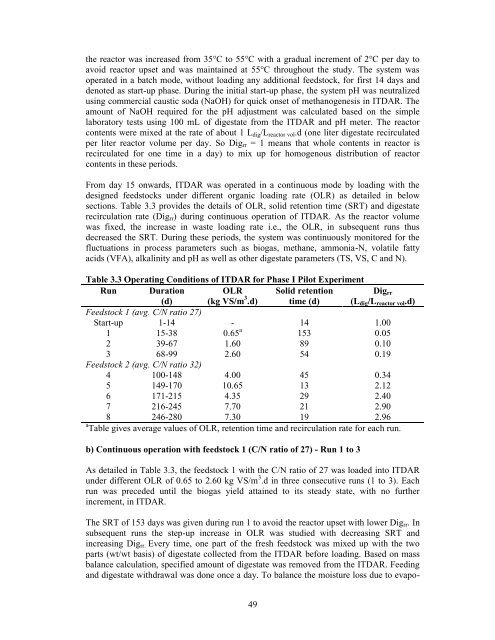dry anaerobic digestion of municipal solid waste and digestate ...
dry anaerobic digestion of municipal solid waste and digestate ...
dry anaerobic digestion of municipal solid waste and digestate ...
Create successful ePaper yourself
Turn your PDF publications into a flip-book with our unique Google optimized e-Paper software.
the reactor was increased from 35°C to 55°C with a gradual increment <strong>of</strong> 2°C per day to<br />
avoid reactor upset <strong>and</strong> was maintained at 55°C throughout the study. The system was<br />
operated in a batch mode, without loading any additional feedstock, for first 14 days <strong>and</strong><br />
denoted as start-up phase. During the initial start-up phase, the system pH was neutralized<br />
using commercial caustic soda (NaOH) for quick onset <strong>of</strong> methanogenesis in ITDAR. The<br />
amount <strong>of</strong> NaOH required for the pH adjustment was calculated based on the simple<br />
laboratory tests using 100 mL <strong>of</strong> <strong>digestate</strong> from the ITDAR <strong>and</strong> pH meter. The reactor<br />
contents were mixed at the rate <strong>of</strong> about 1 Ldig/Lreactor vol.d (one liter <strong>digestate</strong> recirculated<br />
per liter reactor volume per day. So Digrr = 1 means that whole contents in reactor is<br />
recirculated for one time in a day) to mix up for homogenous distribution <strong>of</strong> reactor<br />
contents in these periods.<br />
From day 15 onwards, ITDAR was operated in a continuous mode by loading with the<br />
designed feedstocks under different organic loading rate (OLR) as detailed in below<br />
sections. Table 3.3 provides the details <strong>of</strong> OLR, <strong>solid</strong> retention time (SRT) <strong>and</strong> <strong>digestate</strong><br />
recirculation rate (Dig rr) during continuous operation <strong>of</strong> ITDAR. As the reactor volume<br />
was fixed, the increase in <strong>waste</strong> loading rate i.e., the OLR, in subsequent runs thus<br />
decreased the SRT. During these periods, the system was continuously monitored for the<br />
fluctuations in process parameters such as biogas, methane, ammonia-N, volatile fatty<br />
acids (VFA), alkalinity <strong>and</strong> pH as well as other <strong>digestate</strong> parameters (TS, VS, C <strong>and</strong> N).<br />
Table 3.3 Operating Conditions <strong>of</strong> ITDAR for Phase I Pilot Experiment<br />
Run Duration<br />
(d)<br />
OLR<br />
(kg VS/m 3 .d)<br />
Solid retention<br />
time (d)<br />
Digrr<br />
(Ldig/Lreactor vol.d)<br />
Feedstock 1 (avg. C/N ratio 27)<br />
Start-up 1-14 - 14 1.00<br />
1 15-38 0.65 a<br />
153 0.05<br />
2 39-67 1.60 89 0.10<br />
3 68-99 2.60 54 0.19<br />
Feedstock 2 (avg. C/N ratio 32)<br />
4 100-148 4.00 45 0.34<br />
5 149-170 10.65 13 2.12<br />
6 171-215 4.35 29 2.40<br />
7 216-245 7.70 21 2.90<br />
8 246-280 7.30 19 2.96<br />
a<br />
Table gives average values <strong>of</strong> OLR, retention time <strong>and</strong> recirculation rate for each run.<br />
b) Continuous operation with feedstock 1 (C/N ratio <strong>of</strong> 27) - Run 1 to 3<br />
As detailed in Table 3.3, the feedstock 1 with the C/N ratio <strong>of</strong> 27 was loaded into ITDAR<br />
under different OLR <strong>of</strong> 0.65 to 2.60 kg VS/m 3 .d in three consecutive runs (1 to 3). Each<br />
run was preceded until the biogas yield attained to its steady state, with no further<br />
increment, in ITDAR.<br />
The SRT <strong>of</strong> 153 days was given during run 1 to avoid the reactor upset with lower Digrr. In<br />
subsequent runs the step-up increase in OLR was studied with decreasing SRT <strong>and</strong><br />
increasing Digrr. Every time, one part <strong>of</strong> the fresh feedstock was mixed up with the two<br />
parts (wt/wt basis) <strong>of</strong> <strong>digestate</strong> collected from the ITDAR before loading. Based on mass<br />
balance calculation, specified amount <strong>of</strong> <strong>digestate</strong> was removed from the ITDAR. Feeding<br />
<strong>and</strong> <strong>digestate</strong> withdrawal was done once a day. To balance the moisture loss due to evapo-<br />
49

















